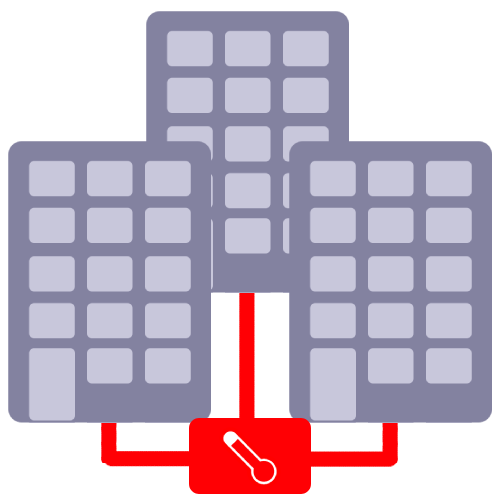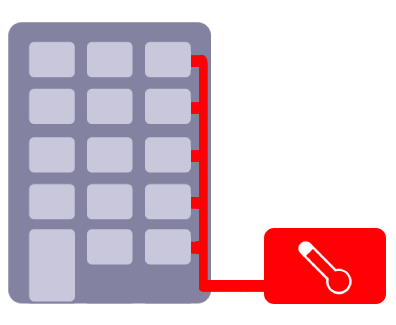Certified by the following organisations

Also known as district heating, heat networks are systems that provide a more energy efficient option to individual boilers. They do this by sharing one heating system for either multiple buildings, or one building with multiple occupants who would usually have their own heating system. One large central source of production (e.g. an energy centre incorporating a number of technologies or a large boiler) is used to heat or chill water which is then distributed to a minimum of 1 final customer via pipework for heating, cooling, or hot water.
The Regulations define the main components of a heat network as:
While there is a limitation on how the heat is transferred for it to count as a heat network, there are no restrictions as to what technologies the central heat source can use. The following list includes, but is not limited to, examples of technologies that can be used to heat:


Communal heating is a single building with a minimum of two final customers who use the distribution of thermal energy in the form of steam, hot water or chilled liquids from a central heat source through pipework to use for space or process heating, cooling, or hot water. There is no requirement that the central heat source is in the building, however it must only be one building that makes use of the heat.
Prior to 2014, heat networks were unrecorded and unregulated. The Heat Network (Metering and Billing) Regulations 2014 were brought in to both help drive energy efficiency and reduce carbon emissions released; further updates to the regulations in 2015 and 2020 supported this by introducing metering devices. The metering devices decrease energy use and consumer bills, subsequently lowering carbon emissions and supporting fair and transparent billing for customers.
To comply, heat suppliers must submit an initial notification to the Office for Product Safety Standards (OPSS) of any new heat network on or before the day it becomes operational (the first day it supplies heating). This can be done by completing this notification template and emailing it in Excel format to heatnotifications@beis.gov.uk. After the first notification, heat suppliers must submit a new re-notification every four-year period after, for every network that they operate. Please note that all notifications and re-notifications must use the template linked above until OPSS releases its new template.

As of November 2020, heat suppliers must define their buildings into classes (see tables below to find out which classes your building should be in) and where necessary, use a specially developed cost-effectiveness tool to assess whether it would be cost effective for them to install meters in their property(s), and act accordingly depending on which class they are put in. Building classification and the use of the cost effectiveness tools if necessary must be done by 27th November 2021. If meters must be installed then this must all be implemented and functioning for use of billing by 1st September 2022.
The three building classes are:
Below are tables created by the government to help heat suppliers class their buildings:
| Buildings supplied by a district heat network which fall into the viable class | Buildings supplied by communal heating which fall into the viable class |
|---|---|
A newly constructed building connected to a district heat network on or after 27th November 2020. This includes new buildings added to existing heat networks as well as those constructed before 27th November but connected on or after this date. |
A newly constructed building (not in the open or exempt class) connected to communal heating on or after 1st September 2022. This includes buildings which are constructed on or after this date. Some new buildings with communal heating fall into the open or exempt class (please see relevant tables). |
A building that undergoes major renovations relating to the technical services (as defined in the Regulations*) on or after 27th November 2020. |
No existing buildings. |
An existing building where meter installations have previously been mandatory. This includes buildings which during the period between 18 December 2014 and before 27th November 2020:
|
No existing buildings. |
*'Technical services' means technical equipment for the heating, cooling, ventilation, hot water or lighting (or any combination thereof) of a building.
| Buildings supplied by a district heat network which fall into the open class | Buildings supplied by communal heating which fall into the open class |
|---|---|
| No new buildings. | A newly constructed building (not in the exempt class) connected to communal heating on or after 27th November 2020 and before September 2022. Some buildings fall into the exempt class.(please see relevant tables). |
| No new buildings. | A newly constructed building (not in the exempt class) connected to communal heating on or after 1st September 2022 where:
Some buildings fall into the exempt class (please see relevant tables). |
| An existing building (not in the viable class) where meters or heat cost allocators are installed in all private dwellings or non-domestic premises in that building. | An existing building where meters or heat cost allocators are installed in all private dwellings or non-domestic premises in that building |
Any other existing building that does not fall into the viable or exempt class (please see relevant tables), this includes but is not limited to:
|
Any other existing building that does not fall into the exempt class (please see relevant table). Existing buildings include those which were not originally constructed to be connected to communal heating but are connected at a later stage, on or after 27th November 2020. |
| Buildings supplied by a district heat network which fall into the exempt class | Buildings supplied by communal heating which fall into the exempt class |
|---|---|
| No new buildings. | A new constructed building, not consisting mainly of private dwellings which is connected to communal heating on or after 27th November 2020 where:
|
Existing building (not in the viable class) where the building (or any part of the building) is:
|
An existing building where the building (or any part of the building) is:
|
An existing building (not in the viable class), where more than 10% of the total number of private dwellings and non-domestic premises are:
|
An existing building, where more than 10% of the total number of private dwellings and non-domestic premises are:
|
An existing building (not in the viable lcass), not consisting mainly of private dwellings where:
|
An existing building, not consisting mainly of private dwellings where:
|
If a property falls into the "Open" class then heat suppliers will need to use on of the following cost-effectiveness tools to determine whether they must install meters or not:
Regardless of installation date, where metering devices are installed on heat networks, heat suppliers must make sure that these devices record the customers’ consumption of heating, cooling or hot water accurately and in continuous operation. Heat suppliers must use meter readings to bill customers, the bills must be issued annually or more regularly and be based on the customers’ consumption, unless an exemption applies.
For the purpose of the Regulations, heat suppliers are defined as
“a person who supplies and charges for the supply of heating, cooling or hot water to a final customer, through communal heating or a district heat network”
Heat suppliers must:
